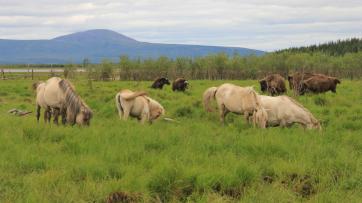Pleistocene Epoch lasted for about 2.5 million years and ended only around 11,000 years ago, so it was not very long ago at all. Pleistocene is classified as having repeated glacial events, it was at the end of Pleistocene when modern humans started to appear. So humans have mostly lived during Holocene, a rather warm period with little climatical shifts. Pleistocene played host to many large fauna, known as megafauna. The megafauna included: Wooly Mammoth, mastodons, saber-toothed cats, glypodons, ground sloths, Irish elk, cave bears, and short-faced bears.
It was believed that the climatical shifts caused the extinction of this group of species…
A man named Sergey Zimov begs to differ.
Zimov has 2 hypothesis’ he intends to prove, but most importantly he intends to help save the planet from 1,400 gigatons of CO2. In perspective, there is an estimated amount somewhere between 700-1000 gigatons of CO2 in the atmosphere right now.
Sergey Zimov believes that the subarctic Pleistocene steppe (an ecosystem present throughout Pleistocene) did not collapse and go extinct because of climate changes, but instead because of humans overhunting. The idea was always that the climate changed, which destroyed the steppe and that caused the extinction of the animals. Zimov argues that it was the elimination of the animals by human interactions that caused the collapse of the steppe.
He is not particularly concerned about the de-extinction of specific species, but instead he is most concerned with the de-extinction of lost traits and interactions and the de-extinction of an ecosystem needed to sustain the planet and contain perhaps the largest terrestrial carbon sinks.
How does one go about proving this hypothesis?
Where do you even begin to prove that 11,000 years ago humans killed off many species and that contributed to the death of an ecosystem and it was not climate? You go buy a tremendous amount of undesirable land north of Siberia and create a park, not just any park, but Pleistocene Park. A park entirely dedicated to reviving all of the lost interactions and thus reviving the lost steppe ecosystem back to the region. A park entirely dedicated to recreating a past epoch. Zimov has already reintroduced 6 species to his park, horses, moose, reindeer, muskox, bison, and wapiti. The steppe is already coming back strong, proving that it was the animals that were responsible for the downfall of the steppe and not the steppe that was responsible for the extinction of the animals.

^Horses and Bison grazing in Pleistocene Park.
What was the park before Zimov and his family took over?
Before the park, the flora life was very poor and the grass was not very healthy. The land became known as permafrost, which has become an incredibly fragile carbon sink. (for more information of how the carbon sink will be sustained, please click permafrost.) The reintroduction of roaming herbivores has increased the herbivory or plant life drastically, seeds are able to be transported and the land is able to be fertilized. This is not even the most impressive thing about the park, I strongly encourage you to click -> permafrost.
^ Thawing permafrost (much like what the park looked before the reintroduction)


4 thoughts on “Pleistocene Park”
Comments are closed.